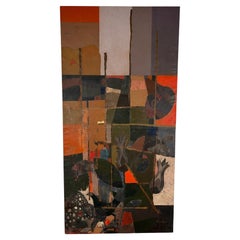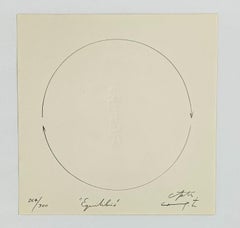Yoan Capote
Large Mixed Media Oil on Canvas by Arnolkis Turro
Located in Denton, TX
of Cuban Contemporary Art, which includes names such as Yoan Capote, Los Carpinteros, Carlos Garaicoa
Category
21st Century and Contemporary Unknown Organic Modern Contemporary Art
Materials
Canvas, Paint
Pillar of Zen #124, unique signed gouache painting Andre Zarre Gallery, 1959
By Charmion von Wiegand
Located in New York, NY
, Ed Buonagurio, Yoan Capote, Sonia Delaunay, Nassos Daphnis, Cathy Diamond, Sari Dienes, Joseph
Category
1950s Abstract Abstract Drawings and Watercolors
Materials
Paper, Gouache
$59,500
H 26.5 in W 25.5 in D 2 in
Recent Sales
Ivan y Yoan Capote, "Untitled" from La Huella Múltiple, 2002, 8.1x8.1 in
Located in Miami, FL
Ivan y Yoan Capote (Cuba, 1973 y 1977)
'Equilibrio (La Huella Múltiple)', 2002
engraving on paper
Category
Early 2000s Contemporary Prints and Multiples
Materials
Paper
People Also Browsed
Pair of Constant Night Stands in Iroko Wood by Master Studio for Lemon
By Lemon
Located in Amsterdam, NL
Neatly proportioned with exceptional detailing, the constant nightstand is your perfect bedside partner. In our furniture making, the IDEA is to create special pieces that you can bu...
Category
2010s South African Minimalist Pedestals
Materials
Hardwood
$6,275 / set
H 24.01 in Dm 13.78 in
White Wash Brutalist Sculptural Collage Artwork, Mural from Upcycled Wood
By Peter Glassford
Located in San Antonio, TX
These WHITE WASH collage tiles are composed randomly from recycled wood remnants and when installed bathe any space with a warm feeling and texture which is meditative, sanded to a s...
Category
2010s Mexican Brutalist Contemporary Art
Materials
Wood
$74 / item
H 23.5 in W 23.5 in D 2 in
"Vigne Fleurie" Signed Limited Edition Art Print by Christiane Lemieux - 30"x40"
Located in New York, NY
"Vigne Fleurie" is an exquisite limited edition fine art print that offers a modernist interpretation of a flowering vine set against a lush green colorfield. Each print is a view of...
Category
2010s American Modern Contemporary Art
Materials
Paper
$2,052 / item
H 40 in W 30 in D 0.03 in
Rare Victorian Firescreen with Taxidermy Hummingbirds by Henry Ward
By Henry Ward
Located in Amsterdam, NL
England, third quarter of the 19th century
On two scrolling foliate feet with casters, above which a rectangular two-side glazed frame, with on top a two-sided shield with initial...
Category
Antique Mid-19th Century English High Victorian Taxidermy
Materials
Other
$230,905 Sale Price
33% Off
H 51.19 in W 55.12 in D 201.58 in
Mid-Century Side Table/Night Stand by Pierre Cardin, 1970's
Located in Vilnius, LT
Mid-century asymmetric two drawer side table/ night stand in wood and metal elements in curved form created by Pierre Cardin in 1970's.
Very good vintage condition.
Category
Mid-20th Century Italian Mid-Century Modern Side Tables
Materials
Metal
$2,273 Sale Price
20% Off
H 25.99 in W 29.73 in D 17.13 in
Set of 6 Handmade Unique Goto Murano Drinking Glasses
By Roberto Beltrami
Located in Murano, VE
The Murano Glass Goto collection brings a piece of authentic Italian art to your dining table. Hand-blown with artistic expertise, these glasses are inspired by the traditional Venet...
Category
2010s Italian Minimalist Figurative Sculptures
Materials
Murano Glass
$284 Sale Price / set
20% Off
H 4.14 in W 2.56 in D 4.14 in
John Widdicomb Hollywood Regency Campaign Black Lacquered Gentleman's Chest
By John Widdicomb
Located in South Bend, IN
An exceptional Mid-Century Modern Hollywood Regency or Campaign style highboy dresser or gentleman's chest
By John Widdicomb
USA, 1950s
Black lacquered solid cherry wood, with ori...
Category
Vintage 1950s American Hollywood Regency Dressers
Materials
Brass
$3,295
H 52.75 in W 36 in D 21 in
Danish Cabinetmaker Three-Seater Banana Sofa, Denmark 1940s
Located in Utrecht, NL
This beautiful Danish three-seater sofa recalls the Art Deco style of the 1930s with the recognizable touch of Danish Modernism. Thanks to its elegantly curved shape, this type of so...
Category
Vintage 1940s Danish Scandinavian Modern Sofas
Materials
Fabric, Wood
Juan Miro Tapestry Labelled by Atelier Jules Pansu, France 1990.
By (after) Joan Miró, Jules Pansu
Located in Brussels, BE
Large rug or tapestry by Juan Miro " L'or de l'azur" edited by Atelier Jules Pansu.
Framed in a black wood box.
Labelled.
France around 1990.
Category
1990s French Mid-Century Modern Tapestries
Materials
Wool, Wood
$3,185
H 59.06 in W 45.28 in D 2.37 in
Vintage Black & White Minimal Neo-Expressionist Abstract Oil Painting
By Michael Pauker
Located in Soquel, CA
Expressive black and white abstract, with scribbled linear patterns in the style of Jean-Michel Basquiat, by by Bay Area artist Michael Pauker (American, b.1957). circa 1977. Oil on ...
Category
1970s Neo-Expressionist Abstract Paintings
Materials
Canvas, Oil
$1,650
H 16 in W 12 in D 0.75 in
Eliel Saarinen Ebonized Dresser Art Deco Johnson Furniture Co 1940s
By Eliel Saarinen, Johnson Furniture Company
Located in Chula Vista, CA
Midcentury modern dresser designed by Eliel Saarinen Johnson Furniture Co. Ebonized oakwood mahogany base.
Dresser for FHA collection
Primavera wood handles in solid wood sculptural...
Category
Vintage 1940s American Art Deco Dressers
Materials
Aluminum, Zinc
On Hold
$3,250
H 30 in W 30 in D 20 in
Vintage Eames lounge chair & ottoman by Ray & Charles Eames for Herman Miller
By Charles and Ray Eames
Located in Buggenhout, Oost-Vlaanderen
Exceptional find! Stylish & original Eames lounge chair & ottoman. A beautiful and very rare combination : Brazilian rosewood with taupe leather. This color was not a standard off...
Category
Mid-20th Century American Mid-Century Modern Lounge Chairs
Materials
Wood
$16,281 / set
H 31.5 in W 32.68 in D 32.68 in
The Gaia Rug by Sister by Studio Ashby
Located in London, GB
The Gaia Rug is inspired by the Greek goddess of earth. It boasts playful abstract motifs and a stunning colour palette that’s sure to make a statement in any space.
This item is ma...
Category
2010s Indian Indian Rugs
Materials
Wool
John De La Rosa Brutalist Sculpture
By John De La Rosa
Located in Dallas, TX
Beautiful large Brutalist sculpture by John De La Rosa.
Category
21st Century and Contemporary American Brutalist Abstract Sculptures
Materials
Iron
Joseph Demarais Limited Edition Nude Print
By Joseph Demarais
Located in Denton, TX
Joseph Demarais Limited Edition Nude Print- Signed. This artist has very unique designs thats he is well known for. He developed an influential process for creating dimensional intag...
Category
Mid-20th Century North American Modern Prints
Materials
Acrylic, Wood, Masonite
Finn Juhl Sofa BO 46 Bovirke
By Finn Juhl
Located in Pawtucket, RI
The perfect Finn Juhl settee manufactured by Bovirke in 1946. Reupholstered with new Hallingdal fabric. Iconic Danish design in perfect restored condition.
Category
Vintage 1940s Danish Scandinavian Modern Settees
Materials
Wool
Get Updated with New Arrivals
Save "Yoan Capote", and we’ll notify you when there are new listings in this category.
More Ways To Browse
Horn And Bone Tray
Hundertwasser Watches
Hunting Dog Cast Iron
Hunting Knives
Hutschenreuther China
Hvidt Chair Cane
Ico Parisi Roma Mim Lounge Chair
Ife Sculpture
Iittala Bud Vase
Ikat Hinggi
Ikea Jarpen Chair
Ikea Moment Vintage
Ikea Moment
Ikea Storvik
Impala Taxidermy
Imperio Rossi
Indian Brass Bottle
Indian Canoe


